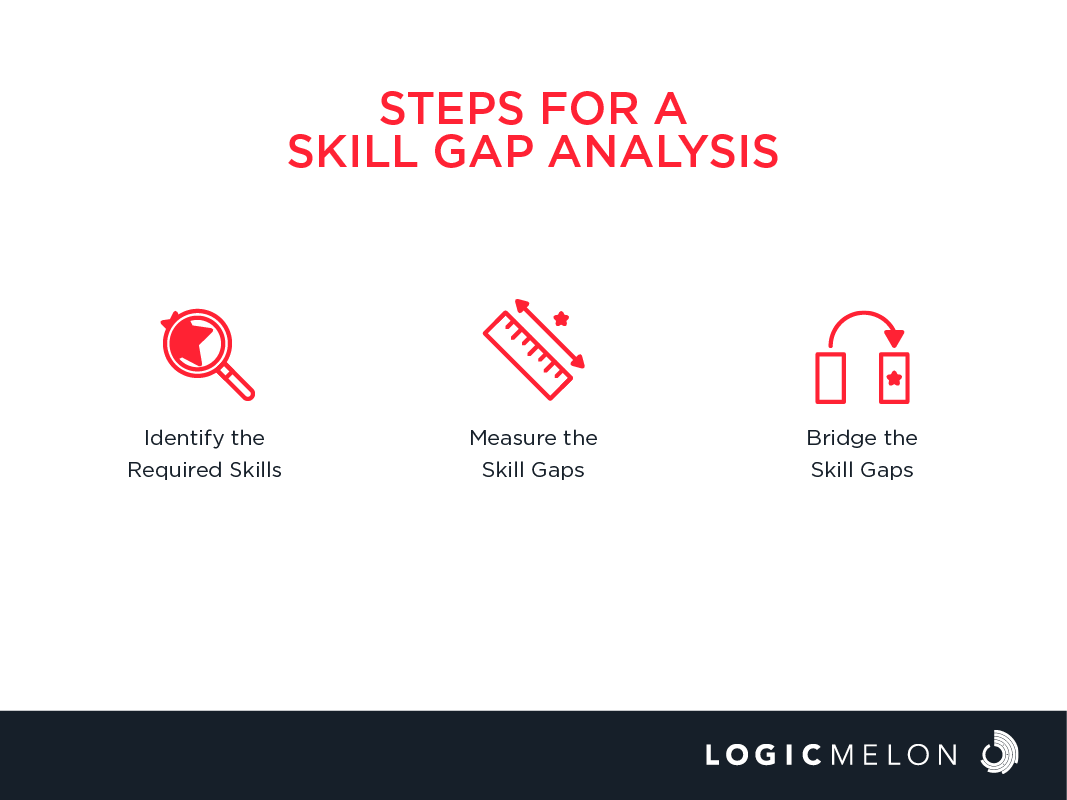Understanding Skill Gap Analysis
No predefined employee skill set can cater to every need of a growing and ever-changing business industry. There will always be a difference in the skills of your employees and the ideal skills required to put yourself at the front of your business. Skill gap analysis will help you with finding and bridging the skill needed for your employees.
The skill difference between the expected skill set and the required skill set is the skill gap. The analysis of such gaps to understand the organisation’s needs and find the employee’s skill requirement is called a skill gap analysis.
When your organisation plans to expand and have well-defined future goals, you should prioritise a skill gap analysis. Once the organisation has an idea of the lacking areas, it can upskill and reskill the employees to match its needs.
In these changing times, some skills would be made obsolete due to automation, and some skills would be mandatory for your employee. A skill gap analysis can provide insights into the skills needed for your organisation’s development. Added to this, there are more advantages of skill gap analysis.
Advantages of a Skill Gap Analysis
- There are many processes involved in a business. Automation is introduced in many processes or a part of them to provide a better experience for the customer and make the employees’ lives easier. As more processes of the job get automated. Specific skills are no longer required, and in place of that, there would be new skills of using the automation software and training employees to use them. Tech-savvy employees would not require such training as they can easily understand automated software usage. A skill gap analysis can help you isolate the employees who need extensive help and focus your training on them.
- Employee development is one of the employee lifecycle stages that measures how much an employee gains from being a part of your organisation. Any employee who feels that they do not have sufficient development and growth will start looking for an organisation that fulfils their development needs. Understanding their needs and training them on the skills they lack can be fruitful for both your organisation and the employee. This improves employee retention.
- A skill gap analysis can give you an idea of the employee’s skills that need to be improved. It can make it easier to boost the employees’ productivity and build their skills for their current job. Employees who have gained the skills required for the job may have a much easier time completing their tasks. It can help them be more content with their work and increase productivity.
- A company’s requirements dictate the hiring process and the hiring team looks out for candidates who have the required skills for the job. But with a skill gap analysis on the current employees, the hiring team can keep an eye out for desirable skills that could help with the organisation’s growth. It helps hire candidates that can build a team of future-proof employees to tackle the upcoming needs.
- To stay ahead of your competitors, use all the tools. The skill gap analysis is one such tool that is crucial to keeping the business competitive. Knowing about your needs and requirements ahead of time will help you make the right decisions for your organisation and come up with initiatives.

The benefits of doing a skill gap analysis are plenty, but how do you make an analysis such as this without making employees feel down. The skill gap analysis is to understand the requirements of your organisation and compare them with the skills of your current employees to understand the skill gap and strategize the growth of your organisation in the proper direction.
1. Identify the Required Skills
First and foremost, to understand and compare the skills of your employees, you need to have a solid idea of the required skills needed for the organisation. Any skills you find worthwhile and plausible enough for future needs should be listed.
After listing the skills you deem required, prioritise them based on the urgency of the requirement and how many current employees already possess such skills. Try to get into a system of labelling each skill and grouping them to make it easier to evaluate the employees for the skills. Come up with a plan that works well and is easy to understand by the major stakeholders of your organisation.
2. Measure the Skill Gaps
After planning the skills required for your organisation, it is time to measure the skill level of your current employees. There are many ways to acquire insights on this. You can use assessments, feedback, surveys, or questionnaires to draw a result on the current employees. After assessing the employees’ skills, place a score on each of them against the required skills. It is mandatory to follow the same criteria for all the employees to ensure that a standardised evaluation takes place.
3. Bridge the Skill Gaps
After validating your findings, it is now time to act on it. Fill the skill gap by engaging your employees by providing training sessions and mentoring them to reduce their skill gap. Try to conduct seminars hosted by employees who already possess the skills. Events, workshops, and online courses would also work based on the skills required and the number of people who need training in that particular skill.
Training the current employees based on the skills required may not always work out, but you can always try to hire new employees with newfound knowledge. Modify the hiring process to cover the needs of the organisation.
Suppose the requirement for a specific skill is urgent, try outsourcing the job to someone with the necessary skill. Even though it is a temporary solution, outsourcing is much faster in fulfilling your needs. Bridge the skill gap by taking your organisation’s needs and the time constraint into consideration.
Conclusion
Understanding the skill gap analysis is vital to make sure each member of your organisation uses it to learn the gaps of their team. The skill gap analysis on the company’s scale can offer more insights and provide help with improving the employee’s skills. A skill gap analysis should cater to the needs of both the employees and the employer.
LogicMelon
Award-winning recruitment software that will find, attract, hire and analyse the way you want to work. At LogicMelon, we have experienced software recruitment marketing specialists to help you build effective recruitment solutions supported by the best customer service you’ll find anywhere!
Email: [email protected] or call LogicMelon (UK) +44 (0) 203 553 3667 (USA) +1 860 269 3089
Cognitive Ability Tests in Recruitment
Cognitive ability tests are used in the recruitment process to evaluate a candidate’s intellectual capabilities, problem-solving skills, and aptitude.
Benefits and Challenges of Outsourcing Recruitment
It is essential for organisations to carefully weigh the pros and cons and choose a outsourcing recruitment partner that aligns with specific needs and objectives.
The Psychology of Decision-making in Hiring
Hiring decisions are more than just the sum of a candidate’s qualifications and experience; they are influenced by decision-making.


